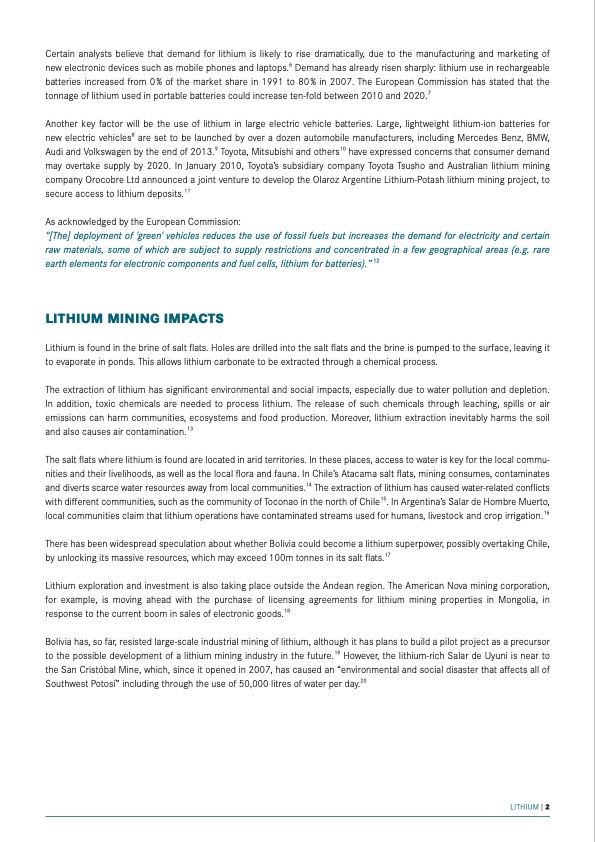
PDF Publication Title:
Text from PDF Page: 002
Certain analysts believe that demand for lithium is likely to rise dramatically, due to the manufacturing and marketing of new electronic devices such as mobile phones and laptops.6 Demand has already risen sharply: lithium use in rechargeable batteries increased from 0% of the market share in 1991 to 80% in 2007. the European Commission has stated that the tonnage of lithium used in portable batteries could increase ten-fold between 2010 and 2020.7 Another key factor will be the use of lithium in large electric vehicle batteries. Large, lightweight lithium-ion batteries for new electric vehicles8 are set to be launched by over a dozen automobile manufacturers, including mercedes Benz, BmW, Audi and Volkswagen by the end of 2013.9 toyota, mitsubishi and others10 have expressed concerns that consumer demand may overtake supply by 2020. in January 2010, toyota’s subsidiary company toyota tsusho and Australian lithium mining company Orocobre Ltd announced a joint venture to develop the Olaroz Argentine Lithium-Potash lithium mining project, to secure access to lithium deposits.11 As acknowledged by the European Commission: “[The] deployment of 'green' vehicles reduces the use of fossil fuels but increases the demand for electricity and certain raw materials, some of which are subject to supply restrictions and concentrated in a few geographical areas (e.g. rare earth elements for electronic components and fuel cells, lithium for batteries).” 12 lithium mining impaCts Lithium is found in the brine of salt flats. holes are drilled into the salt flats and the brine is pumped to the surface, leaving it to evaporate in ponds. this allows lithium carbonate to be extracted through a chemical process. the extraction of lithium has significant environmental and social impacts, especially due to water pollution and depletion. in addition, toxic chemicals are needed to process lithium. the release of such chemicals through leaching, spills or air emissions can harm communities, ecosystems and food production. moreover, lithium extraction inevitably harms the soil and also causes air contamination.13 the salt flats where lithium is found are located in arid territories. in these places, access to water is key for the local commu- nities and their livelihoods, as well as the local flora and fauna. in Chile’s Atacama salt flats, mining consumes, contaminates and diverts scarce water resources away from local communities.14 the extraction of lithium has caused water-related conflicts with different communities, such as the community of toconao in the north of Chile15. in Argentina’s Salar de hombre muerto, local communities claim that lithium operations have contaminated streams used for humans, livestock and crop irrigation.16 there has been widespread speculation about whether Bolivia could become a lithium superpower, possibly overtaking Chile, by unlocking its massive resources, which may exceed 100m tonnes in its salt flats.17 Lithium exploration and investment is also taking place outside the Andean region. the American Nova mining corporation, for example, is moving ahead with the purchase of licensing agreements for lithium mining properties in mongolia, in response to the current boom in sales of electronic goods.18 Bolivia has, so far, resisted large-scale industrial mining of lithium, although it has plans to build a pilot project as a precursor to the possible development of a lithium mining industry in the future.19 however, the lithium-rich Salar de uyuni is near to the San Cristóbal mine, which, since it opened in 2007, has caused an “environmental and social disaster that affects all of Southwest Potosí” including through the use of 50,000 litres of water per day.20 Lithium | 2PDF Image | Lithium Li

PDF Search Title:
Lithium LiOriginal File Name Searched:
13_factsheet-lithium-gb.pdfDIY PDF Search: Google It | Yahoo | Bing
Product and Development Focus for Infinity Turbine
ORC Waste Heat Turbine and ORC System Build Plans: All turbine plans are $10,000 each. This allows you to build a system and then consider licensing for production after you have completed and tested a unit.Redox Flow Battery Technology: With the advent of the new USA tax credits for producing and selling batteries ($35/kW) we are focussing on a simple flow battery using shipping containers as the modular electrolyte storage units with tax credits up to $140,000 per system. Our main focus is on the salt battery. This battery can be used for both thermal and electrical storage applications. We call it the Cogeneration Battery or Cogen Battery. One project is converting salt (brine) based water conditioners to simultaneously produce power. In addition, there are many opportunities to extract Lithium from brine (salt lakes, groundwater, and producer water).Salt water or brine are huge sources for lithium. Most of the worlds lithium is acquired from a brine source. It's even in seawater in a low concentration. Brine is also a byproduct of huge powerplants, which can now use that as an electrolyte and a huge flow battery (which allows storage at the source).We welcome any business and equipment inquiries, as well as licensing our turbines for manufacturing.| CONTACT TEL: 608-238-6001 Email: greg@infinityturbine.com | RSS | AMP |